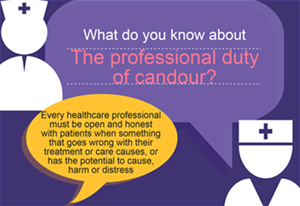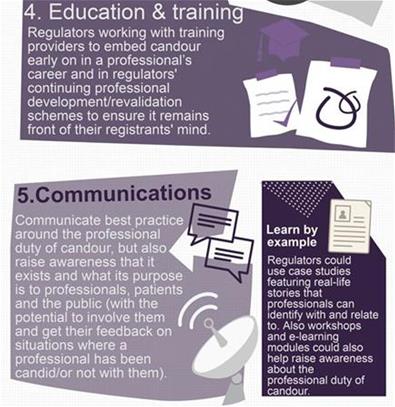by
Michael Warren, Policy Adviser
| Feb 28, 2019
Trust is undoubtedly the basis on which any successful healthcare professional-patient relationship is going to be built. If there is a lack of trust, we cannot realistically expect patients to agree to be examined or undergo risky surgical procedures. The professional duty of candour – that is telling the truth when something has gone wrong with care – is integral to building this trust.

Background and context
The duty of candour, like many policy initiatives was borne out a crisis, by events such as those at the Mid-Staffordshire Foundation Trust – these often result in a push for change and UK policymakers have been focusing on how openness and honesty can be encouraged, this is usually referred to as ‘candour’. In 2014, eight of the nine professional regulators published their joint statement on candour encouraging their registrants to be candid; and enforcing the professional duty of candour through fitness to practise processes.
We have previously undertaken work around candour: advising the Secretary of State in 2013 on whether professional regulation could do more to encourage professionals to be candid. We followed this up with two further reports: one in late 2013 aimed at understanding the limits and potential for regulatory action in this area; and then in November 2014 we published a report outlining progress made on strengthening professional regulation’s approach to candour and error-reporting.
A renewed focus
We felt the time was right to renew focus on candour. We wanted to find out how far policy interventions have come in ensuring that patients can expect professionals to be candid with them. Our recent publication – Telling patients the truth when something has gone wrong is the result. Two main data sources fed into the final report:
- discussion groups with regulators’ staff (mainly staff involved in the fitness to practise process, such as panellists) – discussions were facilitated by Annie Sorbie, Lecturer in Medical Law and Ethics at Edinburgh University
- questionnaires completed by regulators and stakeholders across health and care.
What the report reveals
One obstacle to fully understanding the effects of regulatory interventions on candour is that it is difficult to measure candour quantitatively. How do you measure whether a workforce is more or less candid? It’s even more difficult to measure whether regulatory interventions/encouragement have made any difference. Therein lies the problem. Much of the data and detail around candour is inconsistent and stems from the qualitative nature of candour. One of the research participants highlighted that regulators are in a better position to measure the absence of candour rather than its presence. Regulators can do this through their fitness to practise processes. We need more consistency in collecting the data, the terminology used and look at candour in the wider context, not just from fitness to practise data.
What progress have the regulators made?
The regulators have embarked on various initiatives to embed and encourage candour in their registrants during the last four years. Even with the above caveat in place (about data), the regulators have made progress. They have all pressed ahead in multiple areas to encourage candour in their registrants. They have put in place specific standards requiring registrants to be open and honest when something has gone wrong, and five of the regulators have produced accompanying guidance.
Learn by example
However, our report also reveals that being candid is all very well in principle, putting it into practice can be more complex. Registrants can feel that their regulators are far-removed from the everyday practice of their profession, not subject to the same pressures they face. Questionnaire answers suggested that regulators need to show rather than tell their registrants how to be candid and bring the duty of candour to life. Case studies can provide guidance to registrants based on real-life situations they may find themselves in or, at least, be familiar with.
The Nursing and Midwifery Council (NMC) has produced a number of case studies to help its registrants with the duty of candour, what it means for their practice and how to meet it in a range of scenarios. Other regulators have included specific sections on candour in their indicative sanctions guidance as part of their fitness to practise process.
A proactive rather than a reactive approach to candour
Fitness to practise though is reactive and usually involves an incident where candour is absent rather than present. It could be possible therefore to gauge the absence of candour’s impact on patients and professionals, but not the benefits of professionals being candid. It is also not possible from the fitness to practise data to set the scene. What was the wider context? Is candour absent in the individual healthcare professional or does the place where they work inhibit candour? If so, what are the wider implications for patient safety in this particular organistion?

For patients to really benefit, we need to switch to a more proactive and preventative approach to embedding candour. Regulators need to cooperate with education and training providers to raise awareness about the professional duty of candour to trainees/students and those professionals at the start of their career. Education and training can play a pivotal role in this and regulators have made moves to embed candour, for example, by:
- introducing education and training provider standards which specifically mention candour
- speaking directly to trainees and students to flag and discuss candour issues
- through continuing professional development/revalidation.
Communicating with their registrants
Regulators have also encouraged candour by engaging directly with their registrants. This can be through newsletter articles, short animated videos, training sessions and advice lines, as well as working with stakeholder organisations such as system regulators.
This figure (below) provides an overview of the regulatory tools in place to help registrants understand candour (and can be found on page 31 of the report).

Where do the regulators go from here?
Turning a negative into a positive
Candour is currently viewed and discussed from a more negative angle – usually where there has been a lack of candour, especially as part of a fitness to practise process. Many questionnaire respondents/discussion group participants believed that regulators should take the opportunity to rethink their approach to candour, looking at when a professional has been candid with a patient, or ‘positive’ candour. Fitness to practise could provide the framework for this – as one professional body noted ‘fitness to practise can be an opportunity for regulators to emphasise that candour is not just a duty to be discharged, but a quality to be sought and valued’.
Not by regulation alone: cooperation and consistency
Regulators need to take a consistent approach to incorporating the professional duty of candour in their four core regulatory functions (guidance and standards, education and training, registration and fitness to practise), but they also need to work with other stakeholders.
As already touched on, registrants can feel a degree of separation from their regulators. The capacity of individuals to be candid is mostly influenced by their work environment. In our 2013 report, we identified that many of the barriers that inhibit candour are in the workplace (and these barriers are still present). Regulators are not well-positioned to help their registrants overcome these barriers and need to work in concert with employers, system regulators, professional bodies and other groups who have a more direct impact on professionals’ daily lives.
Read the full report to find out more or see a visual summary of the key findings in this infographic. You can find all our material related to the professional duty of candour here.
Related material
You can find all our work on duty of candour here. Candour is often linked to dishonesty - you can find all our research on dishonesty here.